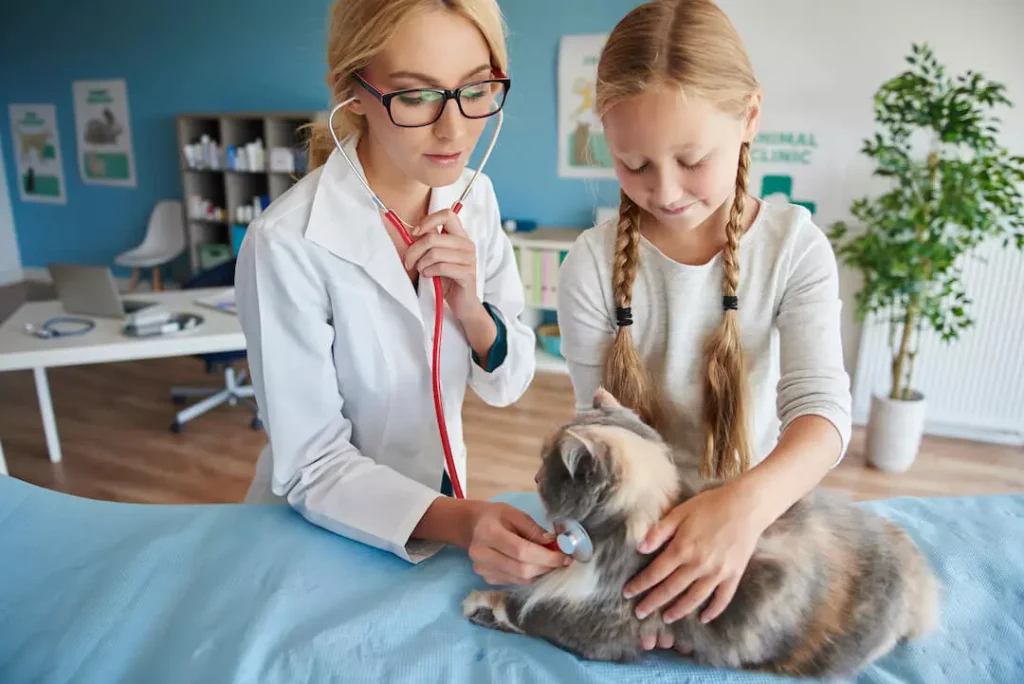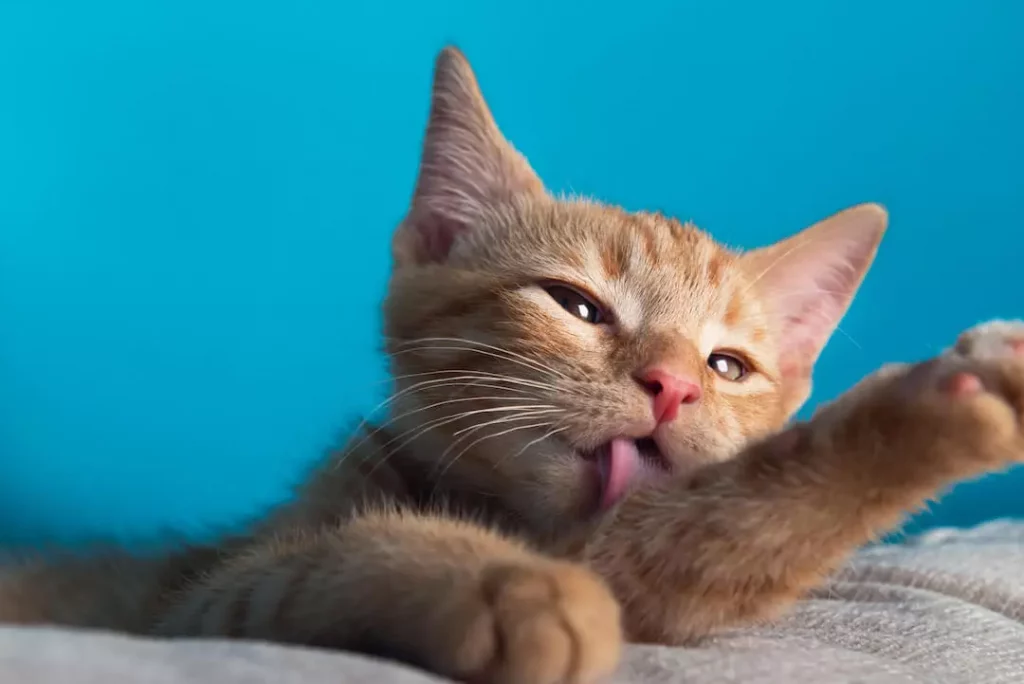Nearly 50% of cats vomiting foam situation happens at some point in their lives, we will discuss in this article the causes, treatment, and prevention tips for your darling cat!
While the majority of cases are not serious, it can be alarming to see your furry friend ejecting chunks of foam. So, what’s behind this unusual symptom? And more importantly, how can you help your cat feel better?
Symptoms
There are a few key symptoms to look out for if you’re concerned your cat is vomiting foam. These include:
- Vomiting foam more than usual
- Having trouble breathing
- Losing weight
- Depression or lack of energy
- Excessive drinking or urinating
If your cat is exhibiting any of these symptoms, it’s important to take them to the vet as soon as possible.
The underlying cause of the cats vomiting foam could be something as simple as a hairball, or it could be a sign of a more serious problem.

15 Causes of Cats Vomiting Foam
There are a variety of reasons why cats might puke foam and the underlying cause will dictate the necessary course of treatment. Some of the most common 15 causes include:
1. Hairballs
One of the most common reasons cats vomit foam is due to hairballs. Cats who groom themselves a lot can often ingest a lot of hair, which can form into balls in their stomach. These hairballs can cause a lot of discomfort and lead to throwing up, often accompanied by foam.
2. Food Allergies or Intolerance
Cats can develop food allergies or intolerances to a wide variety of things, including proteins, grains, and even vegetables. Cats with food allergies will often vomit foam as well as have other digestive problems such as diarrhea or constipation.
3. Infection
A bacterial or viral infection can cause cats to vomit foam, as well as have other symptoms such as fever, lethargy, and a loss of appetite. Infection may occur due to several reasons, such as eating contaminated food or coming into contact with an infected animal.
4. Liver Disease
Liver disease is a serious condition that can cause cats to vomit foam and have some other symptoms, such as jaundice, diarrhea, and weight loss.
5. Parasites
Cats vomiting foam causes can be many and worms are common parasites that can affect a cat’s health. Cats can become infected with worms by eating infected prey or coming into contact with an infected animal. Symptoms of worm infection include vomiting, diarrhea, and a loss of appetite.

6. Tumor
Cats can develop tumors in different organs, including the brain, liver, pancreas, and stomach. Tumors can cause cats to vomit foam as well as have other symptoms, such as weight loss and a lack of energy.
7. Intestinal Blockage
Gastrointestinal obstruction is a serious condition that can happen due to a variety of reasons, such as eating a foreign object, swallowing too much hair, or having a tumor. Cats with an intestinal blockage will often vomit foam and have other symptoms such as constipation, a lack of appetite, and weight loss.
8. Electrolyte Imbalance
An electrolyte imbalance can occur when there is a problem with the balance of minerals in the blood. Cats with electrolyte imbalances will often puke foam and have other symptoms, such as diarrhea, lethargy, and a loss of appetite.
9. Pancreatitis
Pancreatitis is a condition that occurs when the pancreas becomes inflamed. Cats with pancreatitis will often vomit foam, have a loss of appetite and be in a lot of pain.
10. Kidney Failure
Kidney failure is a critical condition that can cause cats to through up foam and have other symptoms, such as excessive thirst and urination, weight loss, and a lack of energy.
11. Inflammatory Bowel Disease
IBS is a condition that causes the intestines to become inflamed. Cats with inflammatory bowel disease will often vomit foam and have other symptoms, such as diarrhea, weight loss, and a lack of energy.
12. Stress
Stress can cause cats to spew foam and have other symptoms, such as hiding, excessive licking, urinating, or defecating outside the litter box.

13. Toxins
Cats vomiting foam reasons can be several and toxins are one of the most dangerous ones. Toxins can have other symptoms too, such as drooling, diarrhea, and seizures.
Some common toxins that can affect cats include:
- Rodenticides (rat poison)
- Insecticides
- Antifreeze
- Plants (such as lilies, which are highly toxic to cats)
- Fertilizers
- Chemicals (such as bleach)
14. Eating Wrong Things
Cats will eat wrong things and this is another of the reasons why cats vomit foam. Cats vomiting foam cases can be prevented by keeping the environment free of poisonous material and things that your cat might eat like strings, rubber bands, yarns, etc.
15. Motion Sickness
Motion sickness is the most common reason for cats to puke foam. Cats often get motion sickness when they travel in a car or boat. Symptoms of motion sickness in cats include vomiting and drooling.
If your cat is vomiting foam, it’s important to take him or her to the vet for an examination. By ruling out any hidden health conditions, you can take the necessary steps to help your cat feel better.
Treatment of Cats Throwing Up Foam
Once the cause of the vomiting has been determined, the vet will likely prescribe treatment. This could include antibiotics for a bacterial infection, medications to treat parasites or surgery for a tumor. Cats with pancreatitis or IBS may require special diets or medications.
If the cause of the throwing up is unknown, the vet may perform tests, such as blood work or a fecal exam, to help determine the cause.
7 Prevention Tips
There are a few things that you can do to help prevent your cat from vomiting foam:
- Keep your cat’s environment free of poisons and things that he or she might eat
- Feed your cat a healthy diet and make sure they have plenty of freshwaters to drink
- Make sure your cat gets plenty of exercises
- Vaccinate your cat against common diseases
- Regularly check your cat’s teeth and gums for problems
- Have your cat’s thyroid levels checked regularly
- Take your cat to the vet for regular check-ups

Conclusion
Cats vomiting foam causes are many. If your cat is throwing up foam, it’s important to it to the vet for an examination. By ruling out any underlying health conditions, you can take the necessary steps to help your cat feel better.
Treatment for cats vomiting foam will vary depending on the cause but may include antibiotics, medications, or surgery.
There are also a few things that you can do to help prevent your cat from vomiting foam, such as keeping your cat’s environment free of poisons, feeding them a healthy diet, and vaccinating them against common diseases.
If you enjoyed reading this article, you may want to checkout What to Feed Dogs with Upset Stomach.
References: